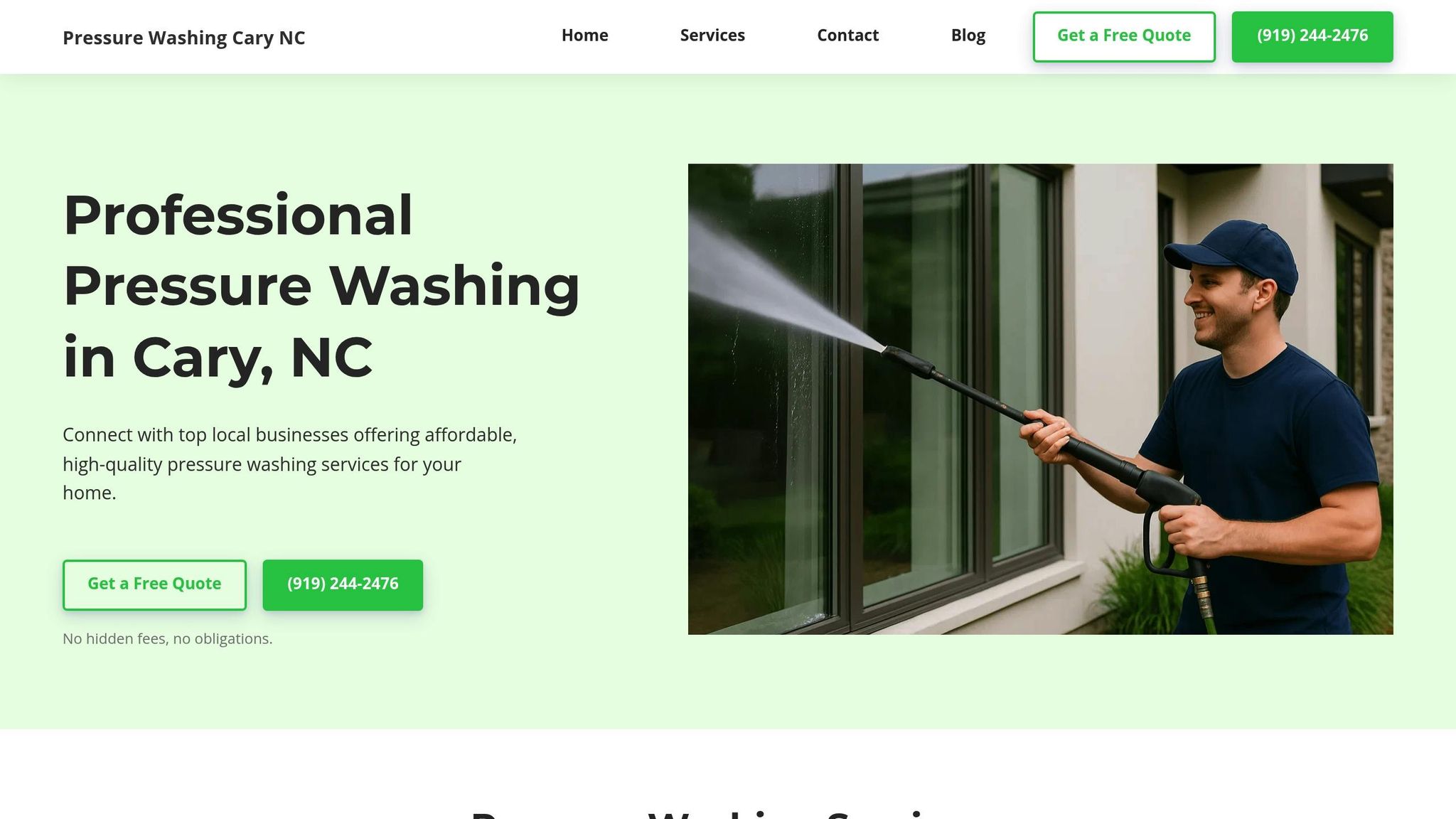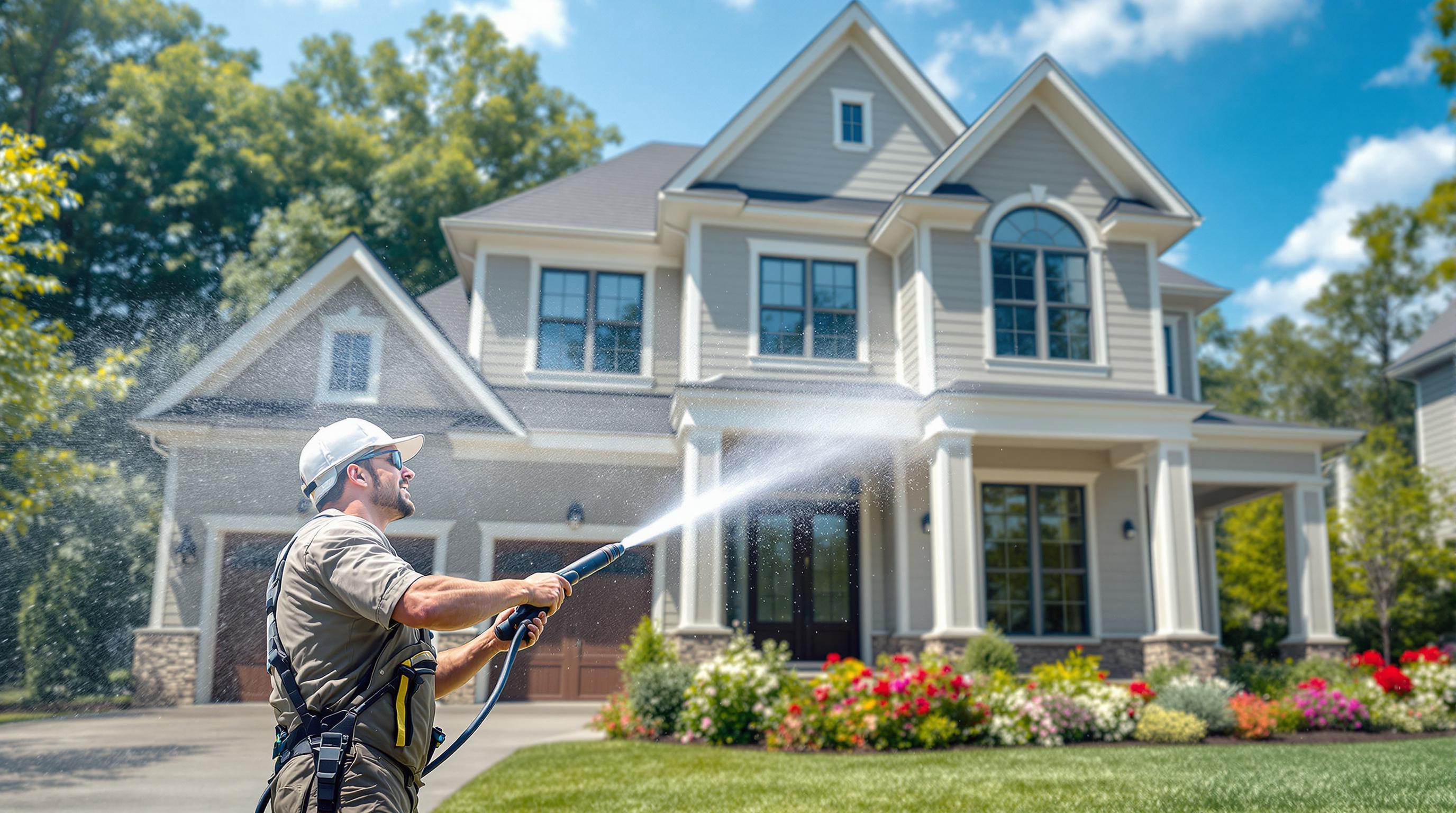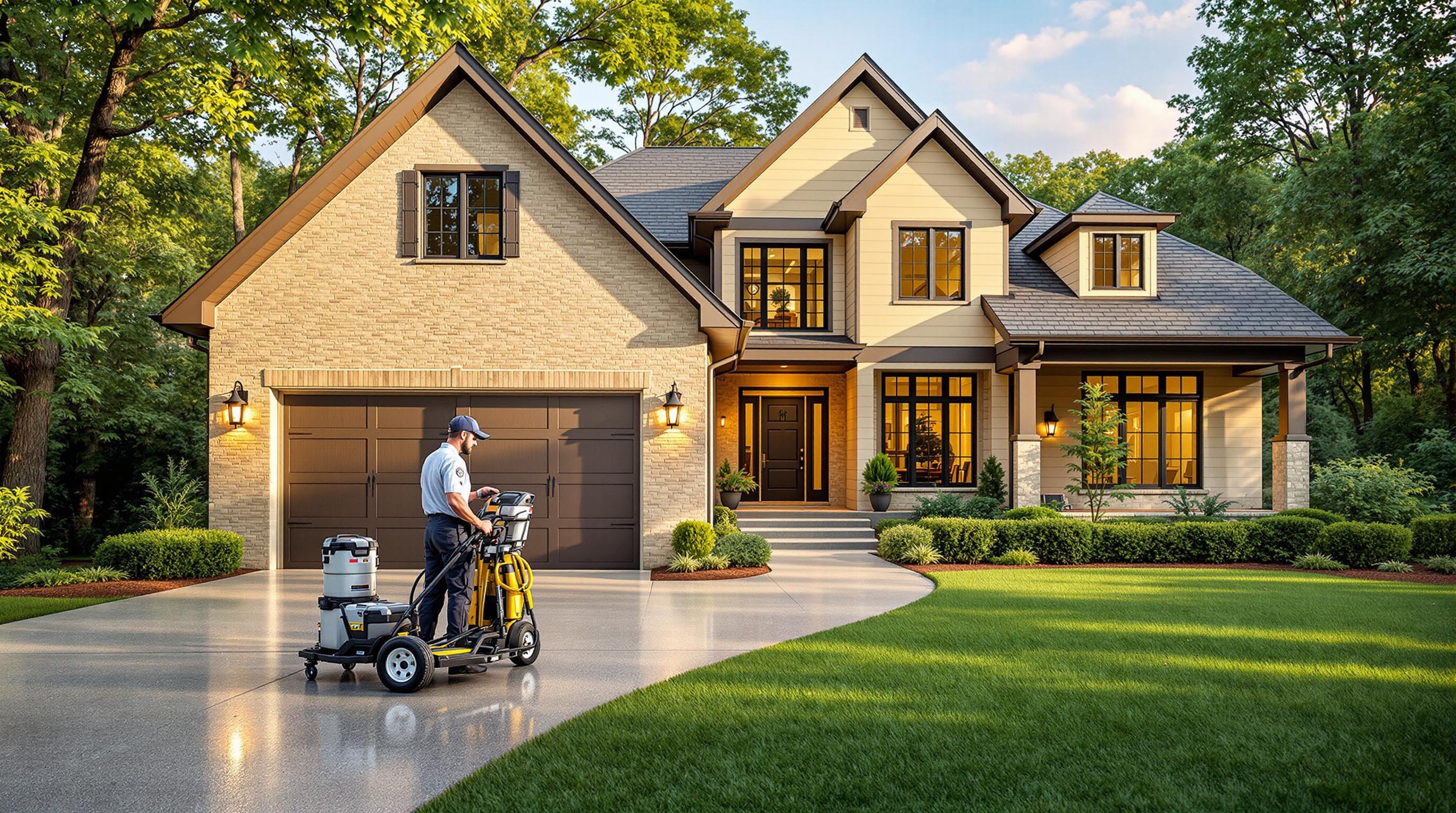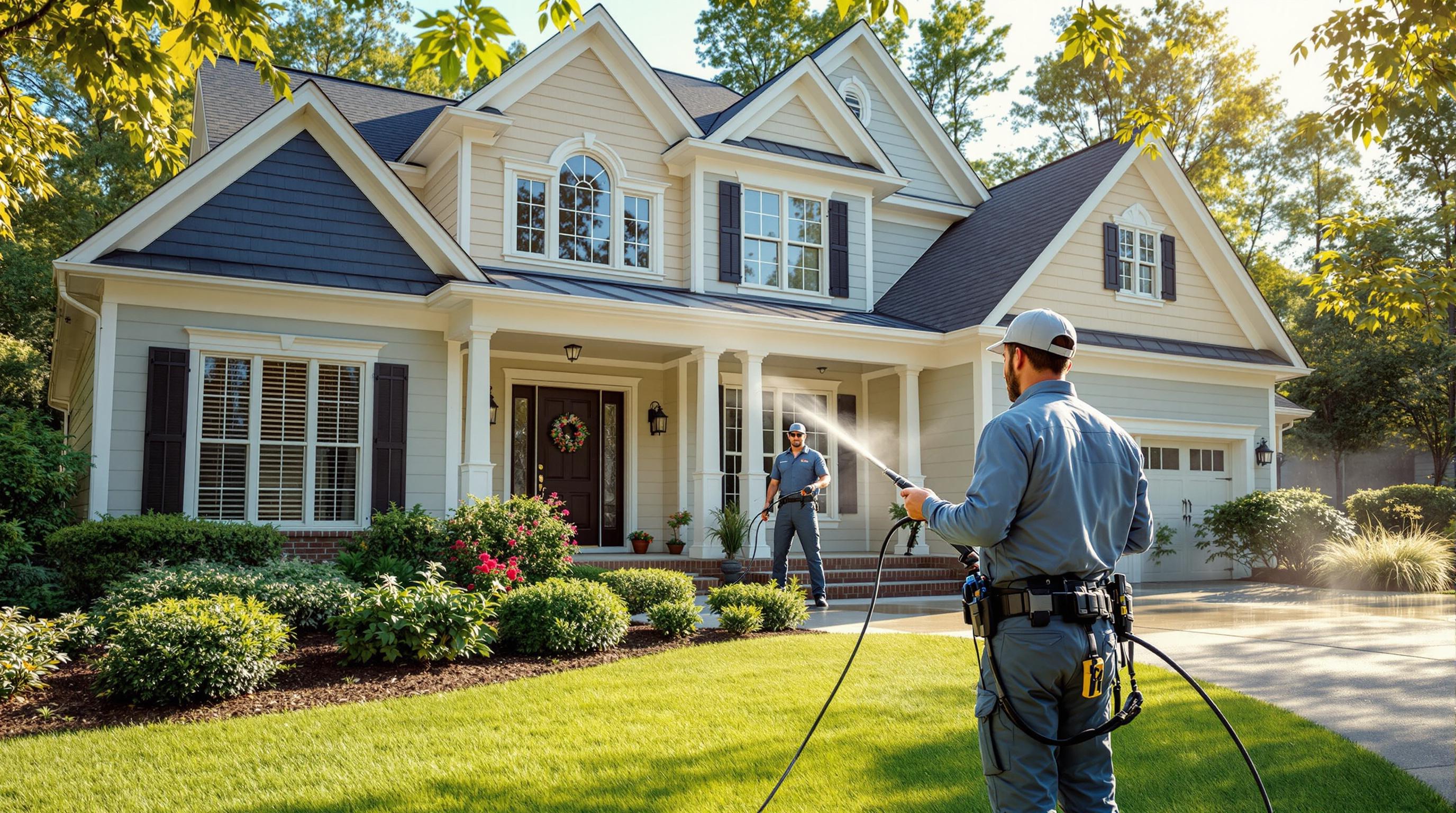When pressure washing wood and concrete, the key is understanding their differences to avoid damage and clean effectively. Wood is porous and delicate, requiring low pressure (500–1,200 PSI) and a gentle touch. Concrete is tougher and can handle higher pressure (2,000–3,000 PSI), but improper techniques can still cause issues like etching or cracks.
Quick Comparison
| Feature | Wood | Concrete |
|---|---|---|
| Pressure (PSI) | 500–1,200 | 2,000–3,000 |
| Nozzle Angle | 25–40° | 15–25° |
| Nozzle Distance | 24+ inches | 12–18 inches |
| Cleaners | pH-neutral, gentle | Strong degreasers |
| Common Issues | Splintering, fuzzing | Etching, pitting |
For wood, use wide fan nozzles and follow the grain. For concrete, use concentrated sprays at an angle. Always test pressure settings on a small area first. Using the right cleaning products and sealing afterward ensures long-term protection for both surfaces.
Moldy, Fuzzy, Filthy Concrete Patio & Wood Pressure ...
Wood and Concrete Properties
Understanding the core characteristics of wood and concrete explains why each material requires specific pressure washing techniques and precautions. These differences influence how they should be cleaned and highlight potential risks if handled incorrectly. Let's break down the structure and sensitivity of each surface.
Wood Structure and Sensitivity
Wood has a soft, porous structure that allows water to seep in quickly. This makes it prone to warping, rotting, or splitting under high-pressure washing. Even pressure-treated wood needs careful handling, as too much force can disturb the surface fibers, leading to permanent damage.
Concrete Strength and Limitations
Concrete is a tough, hardened material that can withstand higher pressure during cleaning. However, it’s not invincible. Excessive pressure or poor technique can cause pitting or worsen existing cracks, especially in older concrete. Using the right pressure settings is key to maintaining its condition.
Here’s a quick comparison of their properties:
| Property | Wood | Concrete |
|---|---|---|
| Surface Hardness | Soft | Hard |
| Porosity | Highly porous | Less porous |
| Water Absorption | High – absorbs water easily | Lower – resists water penetration |
| Pressure Tolerance | Low – needs gentle cleaning | High – can handle stronger pressure with care |
| Damage Resilience | Easily damaged | More resistant to surface impacts |
This table highlights the need for a gentle approach with wood due to its delicate nature, while concrete, though sturdier, still requires careful handling to prevent damage.
Pressure Settings and Methods
Setting the right pressure ensures effective cleaning without causing damage. The trick is knowing how much pressure each material can handle while still getting the job done.
Wood Pressure Settings
When cleaning wood, stick to a pressure range of 500-1,200 PSI. Keep the nozzle at least 24 inches away from the surface, use a 25-40° fan tip, and follow the wood grain with overlapping strokes. Always test on a hidden spot first to avoid accidental damage.
Pro tip: If you see any wood fibers lifting or damage during your test, lower the pressure immediately.
Concrete Pressure Settings
Concrete is tougher and can handle higher pressure. Use 2,000-3,000 PSI (2,500 PSI works well for most residential driveways). Maintain a 12-18 inch nozzle distance, select a 15-25° nozzle, and spray at a 45° angle with slow, overlapping strokes for even cleaning.
Here’s a quick comparison of settings for wood and concrete:
| Parameter | Wood Surfaces | Concrete Surfaces |
|---|---|---|
| PSI Range | 500-1,200 | 2,000-3,000 |
| Nozzle Angle | 25-40 degrees | 15-25 degrees |
| Distance | 24+ inches | 12-18 inches |
| Spray Pattern | Wide fan | Concentrated |
| Movement Speed | Faster | Slower |
| Surface Coverage | Single pass | Multiple passes |
Safety first: Always wear protective gear like eye protection and closed-toe shoes. If you're dealing with a tricky surface or unsure about the right settings, it’s worth reaching out to a professional to avoid any costly mistakes.
Next, we’ll look at cleaning products designed for specific surfaces.
Cleaning Products Guide
Choose cleaning solutions specifically designed for each surface to ensure effective cleaning without causing damage.
Wood-Safe Cleaners
Wood surfaces require gentle cleaning products to maintain their natural appearance. Opt for oxygen-based cleaners or wood-specific detergents with a pH between 6 and 8 to protect the wood fibers.
Here’s a quick guide to cleaning solutions based on wood conditions:
| Condition | Recommended Cleaner | Dilution Ratio | Dwell Time |
|---|---|---|---|
| General Cleaning | Oxygen Bleach | 1 cup per gallon | 10-15 min |
| Mold/Mildew | Vinegar Solution | 1:3 with water | 15-20 min |
| Heavy Stains | Wood Brightener | As directed | 5-10 min |
| Algae Growth | Biodegradable Cleaner | 1:4 with water | 10-15 min |
Avoid using chlorine bleach on wood - it can break down lignin, which holds the wood fibers together.
Concrete surfaces, on the other hand, can handle stronger cleaning agents. See the details below.
Concrete Cleaning Solutions
Concrete is more durable than wood and can withstand tougher cleaning solutions. Choose the right cleaner based on the type of stain:
| Stain Type | Recommended Solution | Application Method | pH Level |
|---|---|---|---|
| Oil/Grease | Degreaser | Pre-treat | 9-11 |
| Rust | Rust Remover | Direct application | 2-3 |
| Organic Matter | Alkaline Cleaner | Mix with water | 10-12 |
| Efflorescence | Acid-Based Cleaner | Diluted application | 1-3 |
Always pre-wet the concrete before applying any cleaner. Wear proper safety gear and test the solution on a small, dry area to ensure compatibility.
Using the right products for wood and concrete ensures effective cleaning while preserving the integrity of the surfaces.
sbb-itb-8e2a680
After-Cleaning Surface Care
Taking care of surfaces after cleaning helps maintain results and ensures long-term protection.
Wood Protection Steps
Let wood dry for 48–72 hours before starting any treatment.
| Step | Timing | Product Type | Coverage Rate |
|---|---|---|---|
| Initial Drying | 48–72 hours | None | N/A |
| Moisture Testing | After drying | Moisture meter | Less than 15% moisture |
| Light Sanding | After drying | 120-150 grit sandpaper | Entire surface |
| Sealer Application | 2 coats | Oil-based or water-based | 200-400 sq ft per gallon |
Sealing Tips:
- Apply sealer when the temperature is between 50°F and 90°F.
- Avoid sealing if rain is expected within 24 hours.
- Use a natural-bristle brush or roller for application.
- Wait 24 hours between coats.
While wood requires a careful and slow approach, concrete surfaces need a more durable treatment.
Concrete Protection Methods
Allow concrete to dry for 24–48 hours before sealing.
| Phase | Product/Method | Duration | Purpose |
|---|---|---|---|
| Drying | Air-dry | 24–48 hours | Remove excess moisture |
| Crack Repair | Concrete patching compound | 4–6 hours cure time | Fix visible damage |
| Surface Prep | Sweep or blow away debris | 30 minutes | Clear loose particles |
| Sealer Application | Penetrating or topical sealer | 4–6 hours between coats | Protect against stains and water |
Sealing Tips:
- Use penetrating sealers for areas like driveways and walkways.
- Opt for topical sealers for garage floors and patios.
- Apply thin, even coats for the best results.
- Ensure the surface temperature stays between 50°F and 85°F during application.
For expert advice and precise application, professional services like Pressure Washing Cary NC can help ensure your surfaces are well-protected and last longer.
Surface Comparison Chart
This chart highlights the main differences between wood and concrete surfaces for pressure washing, providing practical guidance for effective cleaning.
Wood vs. Concrete Details
| Characteristic | Wood Surfaces | Concrete Surfaces |
|---|---|---|
| PSI | 500–1,200 | 2,000–3,000 |
| Nozzle | 25–40° wide spray | 15–25° medium spray |
| Distance | 24–36 inches | 12–18 inches |
| Water Temp | Cold water only | Cold or hot water |
| Cleaners | pH-neutral wood cleaners | Alkaline degreasers (pH 9–11) |
| Common Issues | • Splintering • Grain raising • Fuzzing |
• Surface etching • Efflorescence • Pitting |
| Surface Prep | • Remove debris • Cover plants • Check moisture |
• Sweep surface • Remove oil • Fill cracks |
| Treatment | Oil or water-based sealer | Penetrating or topical sealer |
Key Tips for Pressure Washing
- Begin with the lowest pressure setting and increase as needed
- Test cleaning solutions on an inconspicuous area first
- Maintain a steady distance and angle throughout
- Work in small sections to avoid letting solutions dry out
- Rinse thoroughly after cleaning
Pressure Washing Cary NC uses these tailored methods to ensure each surface type is cleaned safely and effectively, protecting the material while achieving the best results.
Professional Service Benefits
Expertise for Different Surfaces
Pressure washing professionals know how to handle various surfaces like wood and concrete safely. They use the correct pressure, cleaning solutions, and techniques to avoid damage while achieving great results.
Some key skills include:
- Material Assessment: Evaluating the condition of the surface
- Equipment Calibration: Adjusting pressure levels precisely
- Solution Selection: Choosing the right cleaning agents for specific surfaces and contaminants
- Technique Application: Maintaining the proper distance and angle during cleaning
Customer reviews often highlight these skills, demonstrating the level of care and precision provided by professionals.
These abilities directly contribute to delivering high-quality cleaning results.
Pressure Washing Cary NC Services

Pressure Washing Cary NC builds on these core skills to offer tailored cleaning services for wood and concrete surfaces. Their experienced team provides a variety of options to meet your needs:
Residential Services:
- Exterior home washing
- Deck and patio cleaning
- Driveway power washing
- Roof cleaning
Additional Services:
- Gutter and window cleaning
- Commercial power washing
"Our partners are committed to providing top-tier service at a great price!" - Pressure Washing Cary NC
With their deep understanding of surface materials, the team ensures proper treatment while safeguarding your property. Hiring professionals also means added peace of mind with insurance coverage and workmanship guarantees - results that are hard to match with DIY efforts.
Summary
Cleaning wood and concrete with a pressure washer requires different approaches due to the unique characteristics of each material. Wood, being more porous, needs a gentler touch, while concrete can handle stronger pressure thanks to its toughness.
Choosing the right cleaning products is just as important. For wood, opt for mild, pH-balanced cleaners, while concrete benefits from stronger degreasers. Beyond product selection, proper technique plays a big role in achieving thorough cleaning without causing damage.
Here are some key tips to keep in mind:
- Test pressure settings on a hidden spot before cleaning the entire area.
- Keep a safe distance between the nozzle and the surface during cleaning.
- Use cleaning solutions designed for the specific material.
- Finish the process with sealing or protective treatments appropriate for the surface.
Professionals take these basics and apply advanced, material-specific methods to ensure surfaces are cleaned effectively and remain protected.


